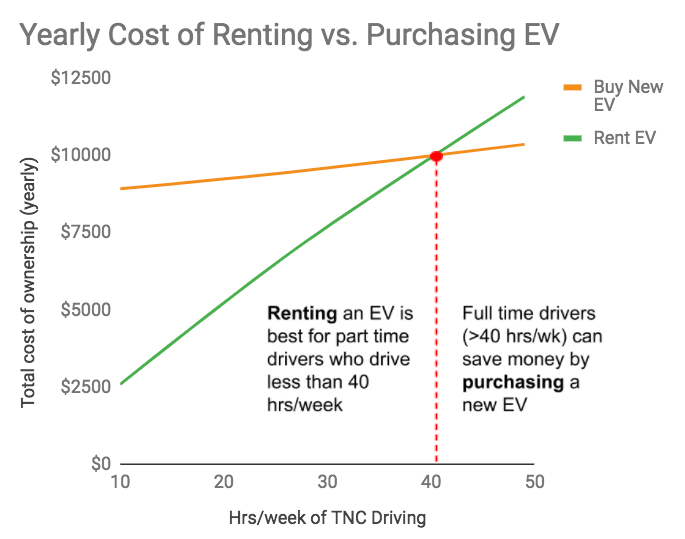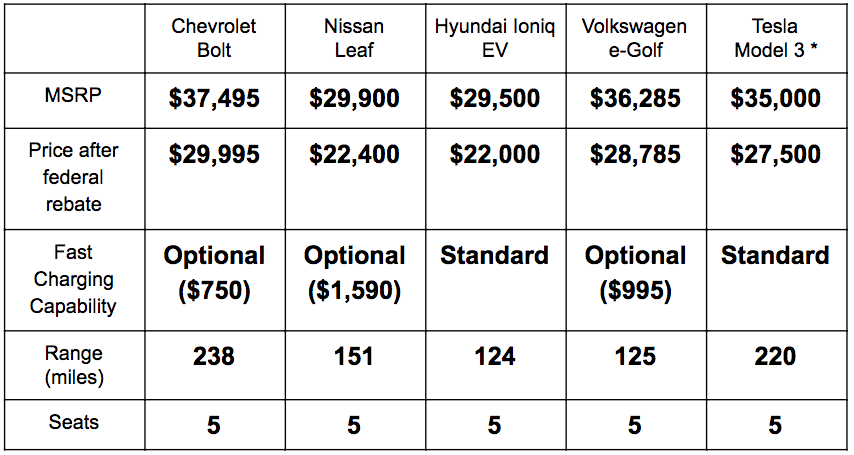
Ride-Hailing Drivers Are Ideal Candidates for Electric Vehicles
The rapid growth of transportation network companies (TNCs) such as Lyft, Uber, and Ride Austin creates a unique opportunity for vehicle electrification, with benefits to cities, drivers, and riders. In New York and San Francisco, TNC and cab rides account for 19 percent of all local vehicle miles traveled during weekdays. If half of these TNC drivers went electric, they would offset 1.5 billion pounds of carbon from the atmosphere each year and improve local air quality within the city.
In addition to these environmental benefits, electric vehicles (EVs) are also significantly cheaper to operate than gas vehicles, despite having a higher up-front price tag. This can be attributed to savings in fuel and maintenance, which scale by how much the vehicle is driven. Highly active TNC drivers are ideal candidates for EVs because they put more miles on their car each year than the average driver. Based on our calculations, full-time TNC drivers working 50 hours a week can save an average of $5,200 per year in total vehicle expenses with an EV as compared to a typical gas vehicle.
The mobility team at Rocky Mountain Institute (RMI) has been targeting high-utilization vehicles for electrification, as they demonstrate the best economics for EV operation and the highest potential for carbon offset. For the past two years, RMI has partnered with the City of Austin, Texas, to support its mobility goals toward developing shared, electric, and autonomous mobility services. Austin offers unique EV charging programs that further bolster the economic savings of driving an electric vehicle.
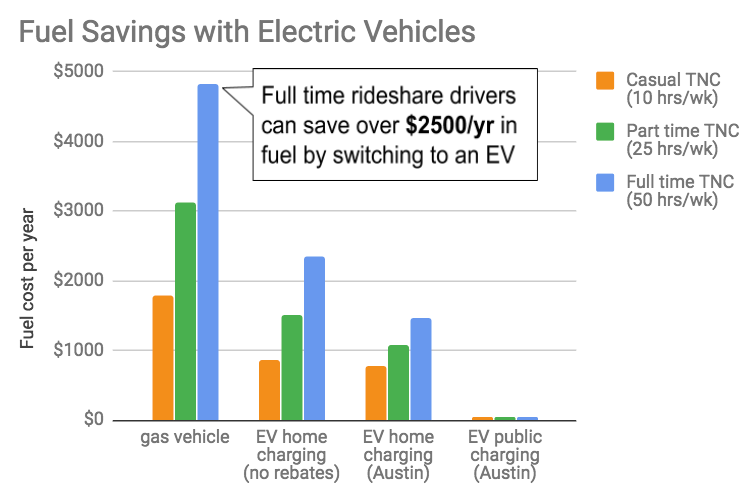
Electric vehicles can be charged at home using a Level 2 charging station, which can be purchased and installed for around $1,200. In Austin, the electric utility provides a rebate of up to 50 percent for a home charging station. Currently, 21 states offer incentives for the purchase and installation of home chargers.
The price of electricity varies by region, but on average is about 12.5 cents per kilowatt hour. This translates to a electricity cost of $0.86 per eGallon , almost a third of the cost of fueling a gas vehicle. Certain electric utilities provide special rates for EV charging at night, which can cut down fuel costs even more. Austin Energy offers a flat rate of $30 per month for unlimited off-peak charging at home through its EV360 program.
Austin Energy also offers a unique program that provides unlimited access to its public charging network for only $50 a year. However, even without any special charging programs or rebates, full-time TNC drivers can save over $2,500 a year in fuel costs by switching to an EV.
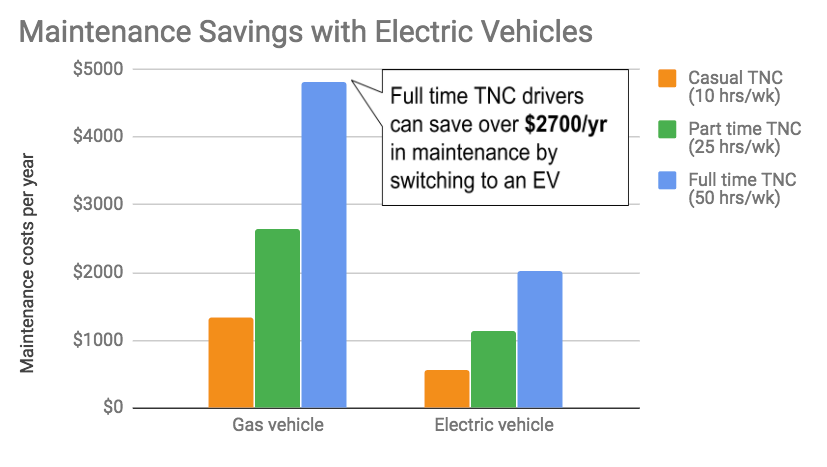
Electric vehicles require much less maintenance than a comparable gas vehicle because they have fewer moving parts. For example, EVs don’t require oil changes, air filters, timing belts, or spark plug replacements, and their regenerative braking systems extend the life of the brakes and rotors. The only significant EV component that will require replacement is the battery, which is covered by all EV manufacturers’ warranties for at least eight years or 100,000 miles.
Using actual maintenance and repair costs from data aggregators such as Edmunds and YourMechanic.com, RMI conducted an analysis to model maintenance costs for EVs and gas vehicles as a function of mileage. This quantifies the well-known fact that older gas vehicles cost more to maintain because of their more frequent and unexpected repairs.
In the first year, full-time TNC drivers can save over $2,700 per year in maintenance and repair costs by switching to an EV. Over five years, the savings total as much as $21,000, as gas vehicles become increasingly more expensive to maintain at higher mileages. Over the lifetime of an electric vehicle, savings in maintenance and repairs offset the cost premium of purchasing an EV.
Is an EV right for me?
EVs generally have a higher upfront price tag than gas vehicles, but are cheaper to operate in the long term. As a result, we recommend EVs for TNC drivers who:
- Drive more than 20 hours a week. Drivers who put a lot of miles on their cars benefit the most from EVs, which are cheaper to fuel and maintain.
- Drive an older vehicle (2007 or earlier model). Older vehicles are more expensive to maintain and may not meet the model year requirements for TNC companies.
For TNC drivers into these categories, we compare different options for obtaining an electric vehicle below.
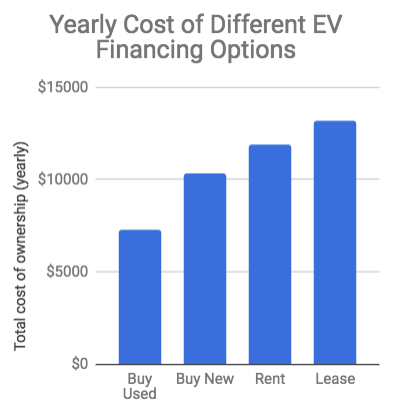
Purchasing a used EV
The cheapest way to obtain an EV is through the used EV market. If you are considering a used EV, keep in mind that older EV models tend to have a lower range (~100 miles) and may be subject to battery degradation. Assess if a used EV would a good fit for you based on your driving needs and charger availability. To avoid premature battery replacements, we recommend getting a battery inspection from a certified dealer.
Purchasing a new EV
New EVs are generally more expensive than gas vehicles, but the higher price tag can be offset by the $7,500 federal tax credit and state rebates or incentives. Full-time drivers who drive more than 40 hours a week can save money by purchasing a new EV.
Renting
Flexible rental programs offer an affordable, low-commitment option for trying out an EV. They can be reserved on an hourly or weekly basis, and do not have long-term contracts or credit requirements. Renting an EV is best for casual TNC drivers who drive less than 40 hours a week, or for drivers who want to “test drive” an EV before purchasing one.
- Turo lets you rent personally owned vehicles on a daily basis. Filter for electric vehicles and your price range. Insurance is included. Available in most US cities.
- Maven Gig offers the Chevy Bolt EV for weekly rental, and in some cities, free charging is included as a promotional event. Standard rentals also include unlimited miles, maintenance, insurance, and roadside assistance. Now available in eight major US cities; coming to Austin in March 2018.
- Envoy There provides EVs stationed at housing complexes for use by their residents on an hourly basis. Now available in Los Angeles, coming to Austin in summer 2018.
Leasing
EV leases are an option, but they typically have mileage limits with overage fees. This can be restrictive for TNC drivers, who often exceed these mileage caps. The one exception is Hyundai’s unlimited mileage lease program for the Ioniq EV, which is limited to California residents.
Best EVs for TNC Drivers
When comparing EV models, consider what range will suit your driving needs. On average, a full-time TNC driver will drive 136 miles per day. At this mileage, you can do all your charging at home with a high-range vehicle. Alternatively, you can purchase a lower-range vehicle and recharge on your lunch break on a DC fast charger, if such chargers are available in your area.
* Scheduled to enter mass production by late 2018.
Although electric vehicles were once considered a niche market, they have become cheaper and more accessible with the release of recent models. The cost premium of EVs compared to gas vehicles is further offset by government incentives and low operational costs. TNC drivers are especially well-positioned to benefit from these lower operating costs, since they drive more miles than the average driver. The yearly savings in fuel and maintenance for EVs will more than offset the higher up-front cost. The widespread electrification of TNC vehicles has the potential to improve driver economics and substantially mitigate carbon emissions in American cities, while exposing large numbers of riders to the benefits of electric vehicles.
Image courtesy of iStock.
